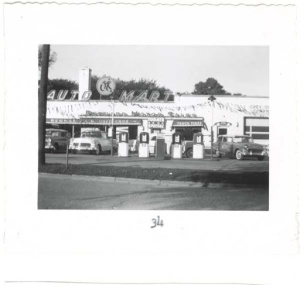While scrolling through some microfilmed issues of old newspapers at the library, we happened upon this charming 1927 article extolling the “progress” of enhanced transportation down Milwaukee Avenue.
“One thing that is foremost in the minds of most all people in Libertyvilleis the vast change that has come about in the last three or four years. This is ever present in their minds, because it is ever before their eyes. It isn’t hard for many of us as we gaze at the never ending cavalcade of cars that roll along through town from sun-up to sundown and long into the night, to go back just a few short years and visualize the few automobiles which toiled and struggled over a bumpy, rutty Milwaukee Avenue…” (The Independent Register, January 6, 1927)
What would the author of this article think of the cavalcade of cars rolling down our main street now, an average of 23,000 to 30,000 vehicles passing through town per day?
Milwaukee Avenue has always been the major transportation artery of our town. It was first an old Indian trail, then the “Milwauky Trace,” the pathway for pioneers who settled here. From 1836 to the late 1870s the Frink and Walker Stage Coach line began transporting riders on this road from Chicago to Milwaukee with regular stops in Libertyville. At the time, hitching posts lined the street and horses and wagons filled the “parking” spaces, especially on market days.
If the weather was particularly wet, wagons stuck fast in low parts of the muddy street. To solve the problem the road was “corduroyed.” Logs were set into the road surface to prevent deep ruts, but passengers endured a ride filled with rough jolts. Later when wide gravel beds were discovered in Libertyville, this material-at-hand was used to build up the roadbeds.
At the turn of the century, occasional automobiles appeared on the dirt road, kicking up so much dust that it became a huge annoyance. Heavy oil was sprinkled over the surface to blanket the dust, but the gummy residue stuck to shoes and ruined carpets as it was tracked into houses. In 1922 local folks finally appealed to the state for roadwork funding. The cost of paving Milwaukee Avenuewith concrete was shared and the new road opened to increased traffic.

The 1920s saw a surge in the sales of automobiles, fueled by cheaper cars and the personal freedom afforded by wheels. This was reflected in the auto dealerships that cropped up on our thoroughfare. The earliest of these was Bernard Chevrolet, established by John N. Bernard in 1914. He opened a small shop at 611 N. Milwaukee Avenuewith one mechanic and two hand operated gasoline pumps. Fifteen years later, Ford, Chevrolet, Hupp and Willys Overland Whippet dealers were in business. Dealerships grew rapidly again after World War II and into the 1950s, setting the stage for the extensive car dealer row we have today.
Parts of our modern Milwaukee Avenue would be hardly recognizable by our 1927 author, but who knows what changes might evolve and amaze us in future years.
Discover more from Cook Memorial Public Library District
Subscribe to get the latest posts sent to your email.




